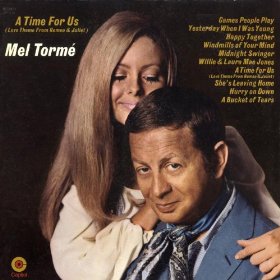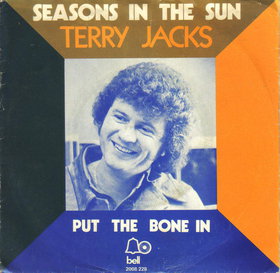Riley Walker, Uranium Minstrel (redux)
Wednesday, August 5th, 2009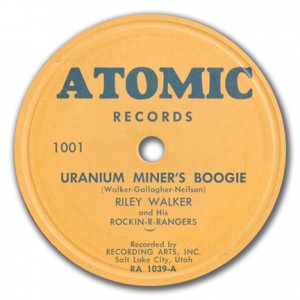
Riley Walker and His Rockin-R-Rangers – “Uranium Miner’s Boogie” (1954)
About a year ago I posted this rare specimen by Riley Walker and His Rockin-R-Rangers – a fine slice of proto-rock ‘n’ roll that I’d gotten my hands on thanks to New Mexico record collector Jerry Richards. Here’s what I wrote at the time:
It was appropriately released on the Atomic label and recorded at Recording Arts, Inc. in Salt Lake City, the “Wall Street of Uranium Stocks” (RAI is no longer with us but until 1944 was run by future LDS church president Gordon B. Hinckley). It’s a great example of a record that spoke directly to its home region, which was Utah and the four corners area, and didn’t circulate much beyond that. It’s also high grade western swing-cum-early rockabilly featuring some of the sassiest of steel guitar riffage.
If you’re familiar with the Southeastern Utah area, you’ll catch the references to Grand and San Juan counties, which were true hotbeds of the post-WWII uranium mining industry, as well as Cottonwood, the southern canyon area near the Grand Staircase (not to be confused with Big or Little Cottonwood canyons, although they’d also work fine in a uranium mining context). And if you’re well-versed in atomic industry history, you’ll recognize acronymic nods to the Vanadium Corporation of America, the U.S. Vanadium Corporation, and the Atomic Energy Commission.
Richards found his own copies of the record in Helper, Utah, which makes perfect sense, as he puts it, “because Helper was, and still is, a mining town.” The record came out as a 78 and a 45, with the 45 version pressed in blue vinyl. Both came packaged in what Richards refers to as “brown paper bag sleeves.”
There’s still quite a bit of homework to be done regarding virtually everything else about this record and the folks who made it happen. The year, for example – I’ve seen it listed as anywhere between 1954 and 1957. The relaxed mastery of the musical idiom along with the casual appearance of “rockin” in the group’s name makes me assume it’s post-1956, but I’d absolutely love it if I were wrong. For now, though, strap on your rock ’n’ roll geiger counters and watch those needles fly.
Well, folks, I was a bit off base. After having an email conversation with Jerry Walker (Riley’s younger brother) and digging up a January 1989 article by Peter Vogel in New Mexico magazine called “Uranium Miners Have a Blast,” I can report that the record indeed came out in 1954. My feeble conjecture that such a relaxed-sounding record from Southern Utah by a group called “Rockin” anything likely couldn’t have pre-dated ’56 was El Wrongo, and I was pretty excited to find this out.
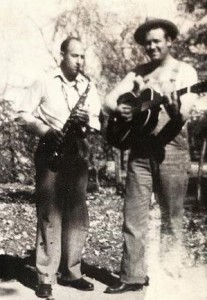
Charles Gallagher (l) and Riley Walker (r)
“Uranium Miner’s Boogie,” in fact, is an authentic relic from those pre-RCA Elvis years of country/R&B cross-pollination (1944-55, say) when “rock” wasn’t so much a genre as it was a descriptive term that hip musicians even as far afield as the four corners area nonetheless flung around fast and loose. Thank heaven Vogel – who was conducting an oral history of the area’s uranium mining industry at the time he wrote this article – was able to track down Walker (a uranium mining veteran who was driving ore trucks in Blanding, Utah, when he made the record) and to get so many choice quotes from the man before he passed away in 2001. Like this one:
Country music took a nosedive after Elvis and we got caught right in the midst of that. Only the strong performers like Eddy Arnold and Chet Atkins and Marty Robbins survived – and Merle [Haggard] who was coming up at that time. Red Foley and Patsy Cline hung on, so did Carl Perkins and Johnny Cash, but it was tough for the up-and-coming, like the Rockin-R-Rangers.
Yes, one of the unfortunate aspects of the King’s ascendance is that he repelled and frightened the established country music industry to such a degree that certain barricades dividing the country genre from youth-oriented influences went up, and by ’61, the likes of Elvis, the Everlys, Jerry Lee Lewis, and Carl Perkins no longer graced the Billboard country charts for the rest of the decade. (Sounds a tad conspiratorial, I know, but grab a copy of Whitburn’s Top Country Hits and see for yourself.) What I’m getting from Walker, surely the hippest uranium miner ever, is that country used to be a lot more fun before it became “country-as-opposed-to-rock-and-roll.”
More revelations from Vogel: Atomic Records, incidentally, was Walker’s own label, and, as Vogel puts it, the label is “the exact yellow that gives refined uranium ore its name: yellowcake.” He distributed copies of the record to stores (where it sold for 98 cents) and jukeboxes all over the region. And its topicality and easy appeal had kept it in regular rotation in some of these jukeboxes for decades. Walker formed the band in 1947 (the same year, incidentally, that Hank Williams’s “Move it On Over,” came out, which “Uranium Miner’s Boogie” will remind some listeners of), and it featured Walker’s sister Belva on piano, a brother-in-law (not Belva’s husband) named Charles Gallagher on steel guitar, and a bassist named Gordon Hawkins.
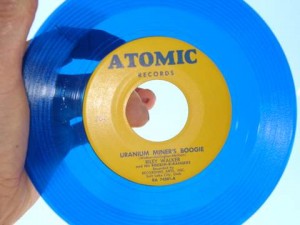
photo courtesy of Jerry Richards
The Rockin-R-Rangers played frequently all over the region, including a dance hall Walker ran himself for awhile in Cortez, Colorado (a town in which he’d also been working as a part time disc jockey for local station KVFC). He called it the Rockin R Rancho, and booked artists like Jim Reeves, Billy Walker, T. Texas Tyler, and apparently Elvis himself who, according to Vogel, was opening up for Tyler at the time. I had no idea that Mr. Presley had ever toured with Mr. “Deck of Cards” and none of my web searching or page flipping has borne this out. (Any Elvisologists care to step forward?)
Walker quit the music business for good when the band split up in ’58, and he drove trucks until ’84. But thanks to this record and the efforts of Vogel, we can safely add Riley Walker and His Rockin-R-Rangers to the very small list of real-deal rock ‘n’ roll pioneers from the Utah and four corners region. And to drive the point home, may I suggest playing the record again and listening while reading the following choice passage from Vogel’s article:
But it was out at the old rustic Buckhorn Club [in Cortez] in the west end of town where things got really lively. There was at least one fight every night and sometimes there would be as many as 20 or 30 people fighting on the dance floor, regardless of the season of the year.
It would be a regular knock-down, drag-out brawl because one guy who would be drinking wouldn’t like the way somebody else would be holding his wife or his girl and that would start the fight. Then friends on both sides of the dispute would jump in and you couldn’t any longer tell who was on which side. “There were too many fists flyin’ around to get very close,” Walker recalls. All the women would get back out of the way and watch the fight sitting at the tables or they would run into the restroom. “But we’d just keep on playin’ and sometimes we might have had to sidestep in case they started fallin’ our way, but generally they left us alone since we weren’t involved. Then the management would call the police and wait awhile.
“Men were more quarrelsome in those days and liked a fight and there weren’t any regular police assigned to the Buckhorn Club, which was known locally as ‘The Bucket of Blood.’ But when the call finally went up that the police were pullin’ in, the men fighting on the floor would all disappear pretty fast so as not to be arrested and taken to jail and the police would arrest whoever was lying out on the floor knocked out.”
As for the present, Riley, Belva, Charles, and Gordon have definitely knocked me out.
posted by Kim Simpson

